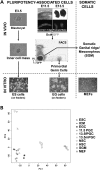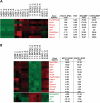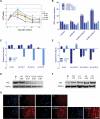Transcriptional analysis of pluripotency reveals the Hippo pathway as a barrier to reprogramming
- PMID: 22286172
- PMCID: PMC3315209
- DOI: 10.1093/hmg/dds023
Transcriptional analysis of pluripotency reveals the Hippo pathway as a barrier to reprogramming
Abstract
Pluripotent stem cells are derived from culture of early embryos or the germline and can be induced by reprogramming of somatic cells. Barriers to reprogramming that stabilize the differentiated state and have tumor suppression functions are expected to exist. However, we have a limited understanding of what such barriers might be. To find novel barriers to reprogramming to pluripotency, we compared the transcriptional profiles of the mouse germline with pluripotent and somatic cells, in vivo and in vitro. There is a remarkable global expression of the transcriptional program for pluripotency in primordial germ cells (PGCs). We identify parallels between PGC reprogramming to pluripotency and human germ cell tumorigenesis, including the loss of LATS2, a tumor suppressor kinase of the Hippo pathway. We show that knockdown of LATS2 increases the efficiency of induction of pluripotency in human cells. LATS2 RNAi, unlike p53 RNAi, specifically enhances the generation of fully reprogrammed iPS cells without accelerating cell proliferation. We further show that LATS2 represses reprogramming in human cells by post-transcriptionally antagonizing TAZ but not YAP, two downstream effectors of the Hippo pathway. These results reveal transcriptional parallels between germ cell transformation and the generation of iPS cells and indicate that the Hippo pathway constitutes a barrier to cellular reprogramming.
Figures






Similar articles
-
Trib2 regulates the pluripotency of embryonic stem cells and enhances reprogramming efficiency.Exp Mol Med. 2017 Nov 24;49(11):e401. doi: 10.1038/emm.2017.191. Exp Mol Med. 2017. PMID: 29170476 Free PMC article.
-
The H3K27 demethylase Utx regulates somatic and germ cell epigenetic reprogramming.Nature. 2012 Aug 16;488(7411):409-13. doi: 10.1038/nature11272. Nature. 2012. PMID: 22801502
-
The Hippo pathway effector proteins YAP and TAZ have both distinct and overlapping functions in the cell.J Biol Chem. 2018 Jul 13;293(28):11230-11240. doi: 10.1074/jbc.RA118.002715. Epub 2018 May 25. J Biol Chem. 2018. PMID: 29802201 Free PMC article.
-
Yes-Associated Protein and PDZ Binding Motif: A Critical Signaling Pathway in the Control of Human Pluripotent Stem Cells Self-Renewal and Differentiation.Cell Reprogram. 2020 Apr;22(2):55-61. doi: 10.1089/cell.2019.0084. Epub 2020 Mar 3. Cell Reprogram. 2020. PMID: 32125897 Review.
-
Induction of pluripotency in primordial germ cells.Histol Histopathol. 2011 May;26(5):643-50. doi: 10.14670/HH-26.643. Histol Histopathol. 2011. PMID: 21432780 Review.
Cited by
-
The EMT spectrum and therapeutic opportunities.Mol Oncol. 2017 Jul;11(7):878-891. doi: 10.1002/1878-0261.12082. Epub 2017 Jun 19. Mol Oncol. 2017. PMID: 28544151 Free PMC article. Review.
-
Differential control of Yorkie activity by LKB1/AMPK and the Hippo/Warts cascade in the central nervous system.Proc Natl Acad Sci U S A. 2015 Sep 15;112(37):E5169-78. doi: 10.1073/pnas.1505512112. Epub 2015 Aug 31. Proc Natl Acad Sci U S A. 2015. PMID: 26324895 Free PMC article.
-
Modulating the Substrate Stiffness to Manipulate Differentiation of Resident Liver Stem Cells and to Improve the Differentiation State of Hepatocytes.Stem Cells Int. 2016;2016:5481493. doi: 10.1155/2016/5481493. Epub 2016 Jan 12. Stem Cells Int. 2016. PMID: 27057172 Free PMC article.
-
High-Level Precise Knockin of iPSCs by Simultaneous Reprogramming and Genome Editing of Human Peripheral Blood Mononuclear Cells.Stem Cell Reports. 2018 Jun 5;10(6):1821-1834. doi: 10.1016/j.stemcr.2018.04.013. Epub 2018 May 10. Stem Cell Reports. 2018. PMID: 29754960 Free PMC article.
-
Shaping Cell Fate: Influence of Topographical Substratum Properties on Embryonic Stem Cells.Tissue Eng Part B Rev. 2018 Aug;24(4):255-266. doi: 10.1089/ten.TEB.2017.0468. Epub 2018 Mar 27. Tissue Eng Part B Rev. 2018. PMID: 29455619 Free PMC article. Review.
References
-
- Keller G. Embryonic stem cell differentiation: emergence of a new era in biology and medicine. Genes Dev. 2005;19:1129–1155. - PubMed
-
- Smith A.G. Embryo-derived stem cells: of mice and men. Annu. Rev. Cell Dev. Biol. 2001;17:435–462. - PubMed
-
- Evans M.J., Kaufman M.H. Establishment in culture of pluripotential cells from mouse embryos. Nature. 1981;292:154–156. - PubMed
Publication types
MeSH terms
Substances
Grants and funding
LinkOut - more resources
Full Text Sources
Molecular Biology Databases
Research Materials
Miscellaneous

